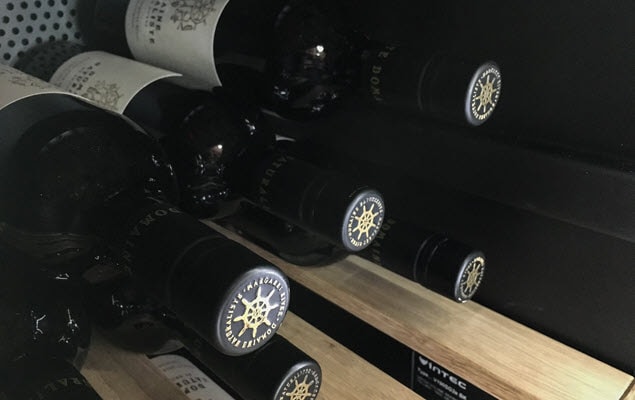In wine, TCA can form in corks that have been treated with chlorine, which reacts with naturally occurring fungi. It has a distinctive aroma that can be detected in minuscule concentrations, and has been responsible for spoiling countless of bottles of wine.
That aroma is most often compared to damp cardboard or moldy cellars. However, the level of infection can vary widely, and everyone has different sensitivities. That sometimes makes it difficult to identify definitively – which is why we’ve probably all tasted corked wine without realizing it.

A corked wine does not mean a wine with small pieces of cork floating around in the glass. It is a word for a wine that has become contaminated with cork taint, which is caused by the presence of a chemical compound called TCA.
In the worst instances, the wine tastes of nothing but mold – which should be obvious. But there are many other times when the wine might just taste a bit flat or dull. Often, you can’t tell if the problem is cork taint, bottle variation, or any of the other things that can go wrong with wine.
The good news is that cork taint is increasingly less common. Screw-caps are a big part of the solution, as is improving technology in cork production. It hasn’t been eradicated, however – and TCA remains a major risk factor, especially with older vintages. Before the 2000s, it was estimated that cork taint affected one in every 20 bottles.

The production of wine corks has decreased a lot the last years. Screw-caps are a big part of the solution, as is improving technology in cork production. Some wines benefit from a screw cap, because it seals the bottle better and doesn't allow in oxygen.
Screw-caps may avoid cork taint, although they are often associated with another wine flaw: excessive reduction. This happens when wine develops sulphur-compound flavors considered unpleasant, similar to cabbage or drains. However, other reductive flavors are much more desirable: the ‘struck-flint’ aroma of top-end Chardonnay, for instance.
Reductive flavors develop due to complex chemical reactions, and they are not necessarily related to a lack of oxygen, as is often assumed. That means that screw-caps are not always to blame – although they might exacerbate the problem. Either way, if a wine is excessively reduced, it can sometimes help to aerate the wine vigorously, preferably in a decanter – but in most cases it is destined for the kitchen sink.

Everyone has different sensitivities and the level of infection can vary widely. Sometimes it is barely noticeable and other times you will notice it as soon as you open the bottle.
Most corked wine meets the same fate. Some people have successfully reduced cork incidence by adding scrunched-up plastic wrap, which has charged electrons that supposedly attract TCA compounds. A better option might be to cook with it, since boiling wine will remove most of its volatile compounds.
If you’re ever unsure if a wine is corked, don’t hesitate to ask the sommelier or shop manager. In the vast majority of cases, they should be happy to replace the bottle for you. Or to play it completely safe, here are three bottles that are guaranteed cork-taint-free.

Crawford River, Young Vines Riesling 2019 Henty
Crawford River are one of Australia’s greatest Riesling producers. From the remote Henty region, this bottling comes from their young vines, and represents a great introduction to their range, with its pristine lime fruit, bright acidity and pinpoint balance. The screw-cap seal ensures perfect freshness every time.
>>Order on Vivino (subject to availability in your location)
Henschke, Johann’s Garden 2017 Barossa Valley
Henschke are not only known for making some of Australia’s most prized (and expensive) reds, but also for not using cork in any of their range. Instead, they use a glass closure called Vino-Lok for their premium wines, including Johann’s Garden. The blend is Grenache and Mataro with a little Shiraz, with deliciously ripe bramble fruit rounded off by subtle oak spice.
>>Order on Vivino (subject to availability in your location)
Cullen, Rose Moon 2018 Margaret River
This lightly sparkling pink wine is a ‘pet-nat’, which is a cloudy style made from fermenting in bottle that is sealed with a crown cap. This is the same closure used for beer, and it is ideal for this style of early-drinking, fresh fizz. Cullen are well-known as one of Margaret River’s best biodynamic winemakers, and this is a very on-trend example of the style – esoteric, textural and earthy.
>>Order on Vivino (subject to availability in your location)
Read These Articles Next

How to choose a good wine cabinet
Whether you like to drink your wine young or let it age gracefully, it is a well-known fact that you must store it in a climate-controlled environment if you want to protect it from spoiling.

Wine climate control systems: Compressors vs. Thermoelectric
We are often asked what the best refrigeration system is when looking for a wine cabinet: compressor technology or thermoelectric cooling?

What’s corked wine?
Widely discussed but often misunderstood, cork taint is a single, specific wine fault. Here’s how to identify corked wine – and what you can do about it. Without realizing it, you have probably tasted corked wine. You might have eaten corked bananas too, or even drunk corked coffee. In each case, the same culprit is responsible, a malodorous chemical known as TCA, or trichloroanisole.

Six expert tips for cellar care
As with any household items, housekeeping is essential for the long-term efficiency of your wine cabinet. It’s also the perfect opportunity to reorganise your cellar based on your “drink now” and “drink later” wines, and to update your Vintec Club virtual cellar management tool.

